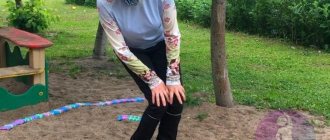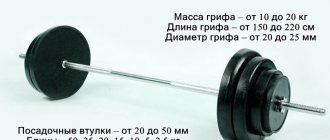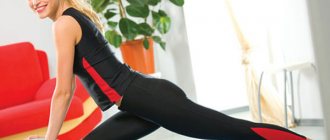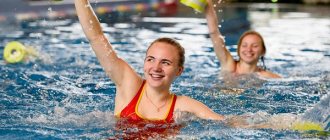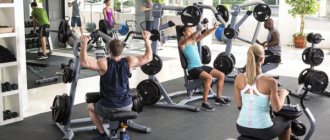Any woman, regardless of age group, strives to look her best. This is not only her desire, but most likely it is laid down at the genetic level. A set of daily exercises will help you remain attractive and charming.
With age, the body changes, and after 40 years, aging begins to appear at the physiological level: metabolic processes slow down, hormonal levels change, the body is no longer so mobile and flexible, what can we say about the body of women who are already over 60, for them there is a separate set of useful training. All this affects both physical and emotional well-being. Despite her age, a woman strives to be active and young. Morning exercises for women over 40 can prolong youth. This is what exactly gymnastic complexes need to be performed and will be discussed.
Morning exercises for women over 40
Most women are almost sure that exercise solves health problems, even those that depend on aging. Of course, no amount of gymnastics can stop the natural processes in the body, but physical activity will help slow down fading and prevent the development of many diseases associated with changes in the body that women think about after forty.
A set of exercises for women will only benefit a fading body if done correctly.
After 40, it is important not only to lead an active lifestyle, but also to carefully approach the loads that make up it.
Squats for firm buttocks
Every woman wants to have round and firm buttocks. But even those lucky women who had an ideal figure without making much effort, after 40 years old will not be so happy with the back part of the body due to a decrease in muscle mass.
Properly performed squats (with a straight back) can tone the body and prevent injury by improving body flexibility.
The benefits of morning exercises
Gymnastics in the morning acts on women as a medicine against many diseases. Its essence is to normalize internal processes and improve the functioning of all organs and systems. It has a positive effect on:
- musculoskeletal system;
- accelerates metabolic processes;
- promotes weight loss;
- normalizes blood sugar and blood pressure (blood pressure);
- increases performance and endurance.
And also for the purpose of prevention, they are prescribed by doctors for diseases of the joints and migraines, for osteochondrosis of the spine.
Plank exercise, 90 seconds 3 times a week
According to the National Institute of Arthritis and Musculoskeletal and Skin Diseases, a division of the National Institutes of Health, most people first experience back pain between the ages of 30 and 40, with back pain becoming more common as they age.
Strengthening your spine can help prevent pain. The plank is a great exercise to try because it tones all the major muscles in the body. According to Perkins, it works not only the abdominal muscles, but also the muscles in the chest and around the spine.
“As these muscles become stronger, the midsection, especially the lower back, becomes stronger, preventing soreness.”
Ideal plank
Get the most out of this amazing exercise by doing it correctly: The Perfect Plank – How to do the exercise correctly?
To perform a plank correctly, place your forearms parallel to each other, elbows under your shoulder joints, and rise on your toes. Your legs should be fully extended and your feet should be shoulder-width apart. Also, be sure to pull your stomach in to “turn on” your abdominal muscles. Stay in the position for 30 seconds, drop to your knees to take a short break, and then repeat the exercise two more times. As you get stronger, try to hold the position for 90 seconds without a break.
Are you wondering how to do push-ups correctly? Read the material where a fitness trainer explains all the nuances of this exercise: Push-ups for a beautiful body: how to perform the most popular exercise
Original article: www.prevention.com
Where to start training?
Before starting complex training, you should make sure that you:
- you can allow yourself to perform certain exercises with increased loads under the supervision of a trainer;
- you have no contraindications to training;
- follow the correct diet, which is calculated based on your age and body characteristics;
- choose the right tracksuit (does not restrict or restrict movement);
- you have the opportunity to accurately follow the training regimen recommended by the trainer.
You also give up bad habits and try to lead a healthy lifestyle.
Preparation for training is an important factor, treat it responsibly.
Training program
A set of exercises is developed according to the individual characteristics of the body. There are a large number of universal complexes that are aimed at solving any problems. For example, for weight loss, muscle building, general strengthening or aimed at a specific disease, such as intervertebral hernia.
General recommended exercises include the following types:
Running in place
Refers to a warm-up type. It also promotes warming, maintains the elasticity of the ligamentous apparatus, and has a positive effect on the joints and skeletal system. Exercises should begin with lightly kneading your feet in place, gradually increasing the pace to a fast one. This requires raising your knees high. When training, keep your back straight, arms bent at the elbow. The maximum speed should be maintained for at least 15 seconds.
An analogue of this complex can be a treadmill.
The back should be straight, there is no need to create additional tension in the lower back.
Lunges with weights
For this exercise, you need to prepare weights (dumbbells, plastic bottles filled with water or sand) weighing 0.5-1 kg.
Starting position: standing straight on a hard surface, arms with dumbbells lowered along the body. We perform a short lunge forward on the leg bent at the knee joint, trying to touch the chest while lifting. In this case, your arms should be straight and raised up. We return back to the original position. We do the same with the other leg.
The number of approaches is no more than 20.
Weights will help create additional stress and force you to put more effort into performing your usual movements.
Burpee
Squat down, with your feet resting on your toes. Palms pressed to the floor. We perform a sharp jump back, without lifting our palms, so that your legs are stretched back, as in the classic push-up version.
Do one push-up from the floor. In the jump we return to the original position. From a squatting position, we jump up, while raising our arms to the top.
The number of approaches depends on your physical endurance. It is advisable to perform 10-15 times.
After several months of training, you can perform burpees with dumbbells in your hands, this way you will increase the load and quickly achieve the desired result.
Grand plié
The basis is an exercise from ballet. Starting position: keep your back straight, feet shoulder-width apart, toes pointing apart.
Take a weight in your hands. Perform squats, keeping your back straight and spreading your knees to the sides. We bend our arms at the elbow joint, while touching the deltoid muscle of the shoulder with weights.
We return to the original position.
The exercise is relevant for girls who want to pump up their buttocks without particularly increasing the massiveness of their legs.
Stretching
Stretching is a set of exercises aimed at stretching ligaments and muscles, as well as increasing the flexibility of the body. Also, in addition to flexibility, during stretching, muscle tension is relieved, posture is corrected, and the functioning of the lymphatic and circulatory system is improved. Can be used as the final part of a workout.
Stretching includes several subtypes: for back stretching, dynamic, for weight loss, strength, for dancers and even for pregnant women.
Pendulum
Initial position: standing on a hard surface, keep the body straight, arms straight along the body. We swing one leg to the side, while bending the other slightly at the knee joint to maintain balance. At the highest point of the lift, fix the leg and hold it in this position for several seconds. We return to the starting position. We do the same with the second leg.
To make the exercise easier, you can hold onto a support (for example, the back of a chair).
The exercise is identical to the “pendulum” with minor changes.
Bike
Starting position: lying on your back on a hard surface. Raises your legs bent at the knees from the floor and begins to perform rotational movements, imitating riding a bicycle. We perform several rotations in one direction and then in the other direction.
In addition to the abs, the exercise also uses the muscles of the thighs, buttocks and back.
Leg Raise
Starting position: lying on your back on a hard surface. We begin to lift one leg up without bending our knees. We do the same with the other leg.
To complicate the exercise a little, you can change the straight leg lift to lifting the leg bent at the knee to the chest, or replace it with the “birch tree”, where you simultaneously lift both straight legs with a slight lift of the lower torso.
The exercise belongs to the class of isolating exercises with a pull type of force and has as its main goal working out the muscles of the “lower” press.
Pilates
You can resort to Pilates, which includes a series of exercises aimed at developing all muscle groups, improving posture and coordination.
Classes include performing complexes with simultaneous deep breathing. Thanks to Pilates, you will tighten the abdominal muscles and the whole body, stabilize the spine, strengthen the muscles, and deep breathing will reduce anxiety, relieve depression and insomnia.
Most often, the Pilantes complex includes the following exercises: stretching one or both legs, boat, hundred, bridge, raising legs on the side and on all fours, rolling on the back, swimming and other complexes.
A ride on the bicycle
Cycling is not only a healthy activity, but also a great pastime. While cycling, the muscles of the back, hips, and buttocks are trained, blood circulation improves, oxygen saturation increases, metabolic processes accelerate, calories are burned, and mood improves. Cycling is considered a preventive measure that is aimed at reducing the development of varicose veins of the lower extremities.
Callanetics
This is a gymnastics complex that was developed by American Callan Pinkney. During training, almost all muscle groups are involved. All exercises are performed at a slow pace, which avoids injuries during training. A total of 29 exercises have been developed, performed in a static position. The results of correctly performed exercises are: correct posture, reduction of back pain, acceleration of metabolic processes, increased immunity, strengthened joints and increased body flexibility.
The purpose of callanetics exercises is to contract and stretch the muscles of the back, hips and abs.
Yoga
Yoga includes a collection of spiritual, mental and physical practices. Of course, yoga is not only exercises for body flexibility, restoration of health and mental balance, but a whole system of self-improvement, starting with the physiological and ending with the spiritual component.
Physical exercises include the following poses: triangle, rocks, cobra, cat-cow and others.
Dance aerobics
Includes a whole range of exercises that are performed to music. Dance aerobics helps to get rid of excess fat, make muscles stronger, improve posture and coordination of movements, and normalize the functioning of the cardiovascular system.
Includes several areas; jazz, hip-hop, rock and roll and other musical styles.
A fun, dynamic activity that harmoniously combines warm-up, stretching exercises, acrobatic elements, lunges, waves, and swings.
Nordic walking
Refers to an amateur sport. During Nordic walking, the muscles of the abdomen, back and shoulder girdle are perfectly trained, there is also increased burning of fat deposits, the functioning of the heart muscle and intestines improves, cholesterol levels are reduced, metabolism is accelerated, and toxins are eliminated from the body faster. Generally speaking, the body is rejuvenated.
How to exercise after 40 years old
It's never too late to start exercising, but it's important to understand that physical activity can be beneficial if you do it wisely. The wrong choice of load can aggravate old injuries and cause irreparable harm to health. After 30 years, women become more vulnerable due to gradual hormonal changes. Well-trained women do not need to radically change their program after reaching a certain age, and for those who do not have long training experience behind them, it is especially important to start training correctly and take age-related changes into account.
How to train a woman after 40 years old
These rules will also be relevant for 30-year-old women who have previously either not trained at all or been involved in sports with long breaks. Different types of training activities have different effects on the body.
Anaerobic (strength) training strengthens muscle and bone tissue, which is extremely important for women 30+ (calorizer). A decrease in the level of sex hormones entails the breakdown of muscle mass and thinning of the bone structure, which is fraught with a slowdown in metabolic processes and the development of osteoporosis. Strength training and a sufficient amount of protein in the diet reduce these risks.
Aerobic (cardio) training strengthens the heart muscle and improves the overall endurance of the body. Since decreased levels of sex hormones are associated with the development of cardiovascular diseases, it is important for women to do cardio.
Stretching is aimed at developing the flexibility of the ligamentous apparatus and improving joint mobility, however, achieving significant body flexibility after 30 is extremely difficult, so stretching is appropriate to use to relax muscles and prevent diseases of joints and ligaments.
According to current WHO recommendations, people aged 18-64 years should:
- Perform strength exercises on the main muscle groups at least 2 times a week;
- Do a minimum of 150 minutes per week of moderate-intensity aerobic activity or a minimum of 75 minutes per week of vigorous-intensity aerobic activity. The optimal amount of aerobic activity per week is 300 minutes, including high-intensity exercise, moderate-intensity exercise and long walking;
- Dedicate at least 3 sessions per week to balance training.
It’s easy to combine all of the above - just do strength training in the gym three times a week, do 20 minutes of cardio and stretching after each session, and on days off from training you can work out at home, visit the pool or go for a long walk.
Strength training for women over 40
If you have been doing strength training for more than a year or have never done strength training before, then you need to start with a simple beginner’s program and adjust it to the individual characteristics of your body, if necessary.
Basic recommendations:
- Work all muscle groups at a time for 2-3 months. This time will be enough to practice the technique in basic exercises.
- Avoid axial load on the spine (squats, deadlifts, bent-over barbell rows, standing presses) - age-related changes make the spine especially vulnerable, so try to perform exercises in sitting and lying positions. Instead of squats, do leg presses, instead of bent-over rows, do lever or horizontal block rows, work the back of the thigh not with deadlifts, but with hyperextension and leg bending in the machine.
- Start your workout by working small muscle groups - this is called the pre-exhaustion principle, where you first give an isolated load to the muscles, and then do a basic exercise where the load falls on the unfatigued muscles, which will allow you to work the muscle group with less weight and with less risk to the joints and ligaments. This means that before doing the leg press, it is advisable to do either leg extensions or leg curls.
Cardio for women over 40 years old
Cardio exercise is good for your heart health and not good for your muscles, so it makes sense to do it along with strength training.
Basic recommendations:
- Start with 10 minutes of cardio after strength training, gradually increasing the time to 20-30 minutes;
- On some days, start with 20-30 minutes of cardio, gradually increasing the time to 45-60 minutes;
- Despite the enormous benefits of HIIT, if you have not done it before, approach intense training carefully - do light intervals, no more than 2 times a week, gradually increasing the intensity. For example, start with four intervals of moderate jogging for a minute and brisk walking for 3 minutes. With each session, increase the time or speed of running and decrease the duration of walking. When the body gets used to it, increase the number of intervals;
- Avoid intense jumping training, step aerobics, and running on asphalt in uncomfortable shoes. As mentioned above, changes in hormonal levels reduce bone density, and the ankle is the most vulnerable place during aerobic exercise. In addition, the shock load falls on the spine.
Stretching for women after 40 years
Flexibility is genetically embedded in us. It can be improved, but if you didn’t do the splits before the age of 16, then after 30 it’s too late to do it. Use stretching for healing and relaxation.
Basic recommendations:
- Always stretch your muscles after training.
- There should be 1-3 exercises for each muscle group - the larger the muscle group, the more exercises.
- Perform the stretch smoothly without unnecessary jerks, holding the final position for 15-20 seconds.
- You can do stretching on a separate day, but only on warmed muscles.
Get ready for the fact that training takes a long time. To achieve an average level of fitness with a competent approach, you will need a year of regular exercise (calorizator). You will see the results of training in the form of reduced fat mass, improved posture and overall well-being within two months, provided you have a properly organized diet, sleep schedule and stress control. You need to have realistic expectations because training at 20 and at 40 are very different, as are your body's capabilities. If you are doing everything correctly and do not see results, you need to consult a doctor; perhaps you have entered menopause and need to adjust your hormonal levels.
Author: Ekaterina G., nutritionist, fitness blogger (especially for) Copying this article in whole or in part is prohibited.
What are the workload characteristics for forty-year-olds?
Physical exercises must be performed regularly, only then will they be truly beneficial. Initially, choose the intensity, mode and time of training for yourself. However, it is better to perform the complexes in the morning. The total duration of classes should not be 1.5-2 hours a day. The optimal number of workouts is 2-3 per week.
Get into the habit of exercising to look and feel younger than your age.
During training, you must also follow your diet. Then the effect will be much better.
You should not do all the exercises in a row. Choose specific complexes and do them regularly. Choose the pace of training individually for yourself. Don't take too long breaks between classes.
Dumbbells for arthritis
Chronic joint pain can occur in adults of any age, and one of the best ways to prevent it is through strength training.
You don't have to spend hours lifting heavy weights. Deadlifting overhead with a weight of 0.5-1.5 kg in each hand 2-3 times a week can do wonders for your body.
Are there any contraindications?
The main contraindications are:
- exacerbation of the disease;
- hyperthermia;
- mental disorders;
- hypertension;
- oncology;
- blockage of blood vessels;
- with severe pain.
To summarize, we can say that if women over 40 regularly perform morning exercises, they can not only improve their health, but also prolong their youth. Of course, you shouldn’t suddenly start intense training; it’s better to have a gradually increasing load on the body. And for those who are more physically prepared, a set of simple movements for the entire body is suitable. Physical exercise will help you achieve results that will have a beneficial effect on health and beauty, despite the years.
